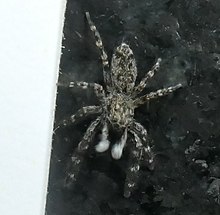
Adoxotoma is a genus of South Pacific jumping spiders that was first described by Eugène Louis Simon in 1909.

Epeus is a genus of the spider family Salticidae. They are often found on broad-leaved plants or shrubs of rain forest, or in gardens of Southeast Asia.

Hinewaia is a genus of the jumping spiders found in New Zealand. Its single described species is Hinewaia embolica.

Pancorius is a genus of Asian jumping spiders that was first described by Eugène Louis Simon in 1902. They are similar to Hyllus.

Zenodorus is a genus of the jumping spiders distributed from the Moluccas to Australia, including several islands of the Pacific. It was once considered a junior synonym of Omoedus, but this was later rejected by Jerzy Prószyński in 2017. At least one species, Z. orbiculatus, specializes on hunting ants.

Huttoniidae is a family of ecribellate araneomorph spiders containing a single genus, Huttonia, itself containing a single described species, Huttonia palpimanoides. It is known only from New Zealand.

Trite planiceps, commonly known as the black-headed jumping spider, is a common jumping spider (Salticidae) endemic to New Zealand and one of about 150 species of jumping spiders in New Zealand.

Trite auricoma, commonly known as the golden-brown jumping spider, is a species of jumping spider endemic to New Zealand.

Wanda Wesołowska is a Polish zoologist known for her work with jumping spiders. She has described more species of jumping spider than any contemporary writer, and is second only to Eugène Simon in the history of arachnology. Originally a student of ornithology, she developed an interest in jumping spiders while still a student at the Siedlce University of Natural Sciences and Humanities in the 1970s.
Psenuc is a genus of spiders in the family Salticidae. It was first described in 2016 by Prószyński. As of 2017, it contains 11 species.
Lechia is a small genus of Asian jumping spiders first described by Marek Michal Zabka in 1985. As of March 2022 it contains only two species: L. minuta and L. squamata.
Neaetha maxima is a species of jumping spider in the genus Neaetha that lives in Ivory Coast and Nigeria. It was first described in 2011 by Wanda Wesołowska & Anthony Russell-Smith based on a holotype found near Ibadan. Only the female has been described. The spider is atypically large, over 10 mm (0.39 in) long, which is reflected in the species name. The genus name can be translated new aspect. It has a light brown carapace and yellow-white abdomen, with orange-brown legs. The epigyne has a distinctive central pocket and wide copulatory ducts.
Neaetha catula is a species of jumping spider in the genus Neaetha that lives in East and Southern Africa. The male was first described in 1886 by Eugène Simon and the female by Ludovico di Caporiacco in 1949. First discovered in Zanzibar, examples have also been identified in Kenya. The spider is small, 3 mm (0.12 in) long, with a generally black cephalothorax and abdomen, although the abdomen has a pattern of spots towards the rear and a thin line that divides it in two. The species can be distinguished from others in the genus by the lack of central pocket in the female's epigyne. This feature led Dmitri Logunov to consider whether the spider belongs to the genus.
Euochin is a genus of east Asian jumping spiders first described by Jerzy Prószyński in 2018. The genus was split off from Euophrys. Prószyński placed the genus in his informal group "euophrydeae" within the "euophryines", the latter being equivalent to the tribe Euophryini, which is part of the subfamily Salticinae.

Holoplatys apressus is a species of jumping spider endemic to New Zealand.
Adoxotoma bargo is a jumping spider in the Salticidae family, which is found in New South Wales.
Maripanthus is a genus of Asian jumping spiders first described by Wayne Maddison, I. Beattie and K. Marathe in 2020.
Parahelpis wandae is a species of jumping spider in the genus Parahelpis that lives in Australia. The spider was first described in 2020 by Barbara Patoleta and Marek Żabka, although only the male has been identified. It is a small spider with a brown carapace 2.3 mm (0.091 in) iong and a grey-brown abdomen 2.45 mm (0.096 in) long. The abdomen has a pattern of chevrons. The remainder of the spider is brown or grey-brown. It is similar to the related Parahelpis abnormis, even to the design of its copulatory organs. It differs in that, although it is similarly hooked, the retrolateral tibial apophysis is not forked.
Ozarchaea forsteri is a species of Malkaridae that is endemic to New Zealand.











